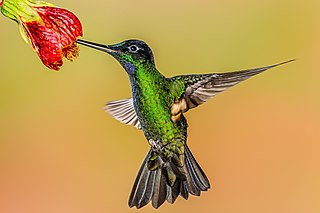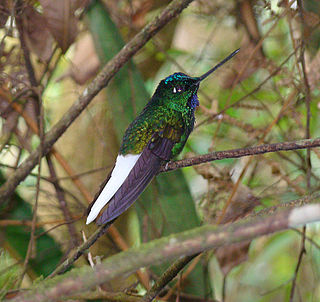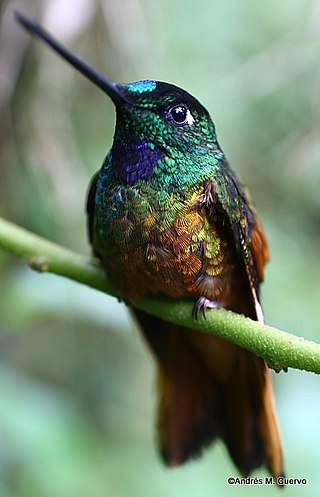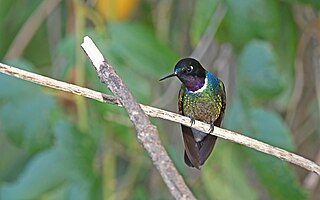
The blue-vented hummingbird is a species of hummingbird in the "emeralds", tribe Trochilini of subfamily Trochilinae. It is found in Costa Rica and Nicaragua.

The sapphire-spangled emerald is a species of hummingbird in the "emeralds", tribe Trochilini of subfamily Trochilinae. It is regularly found in Bolivia, Brazil, Peru, and Venezuela; as a vagrant in Argentina; and has possibly occurred in Ecuador.

The green-bellied hummingbird is a species of hummingbird in the "emeralds” tribe Trochilini of subfamily Trochilinae. It is found in Colombia and Venezuela.

The wine-throated hummingbird is a species of hummingbird in tribe Mellisugini of subfamily Trochilinae, the "bee hummingbirds". It is found in El Salvador, Guatemala, Honduras, and Mexico.

The blue-throated starfrontlet is a species of hummingbird in the "brilliants", tribe Heliantheini in subfamily Lesbiinae. It is found in Colombia and Venezuela.

The rainbow starfrontlet is a species of hummingbird in the "brilliants", tribe Heliantheini in subfamily Lesbiinae. It is found in Ecuador and Peru.

The buff-winged starfrontlet is a species of hummingbird in the "brilliants", tribe Heliantheini in subfamily Lesbiinae. It is found in Colombia, Ecuador, and Peru.

The dusky starfrontlet, also known as glittering starfrontlet, is an Endangered species of hummingbird in the "brilliants", tribe Heliantheini in subfamily Lesbiinae. It is endemic to a few small areas in western Colombia.

The white-tailed starfrontlet is a species of hummingbird in the "brilliants", tribe Heliantheini in subfamily Lesbiinae. It is endemic to the Sierra Nevada de Santa Marta of northeastern Colombia.

The violet-throated starfrontlet is a species of hummingbird in the "brilliants", tribe Heliantheini in subfamily Lesbiinae. It is found in Bolivia and Peru and possibly Ecuador.

The amethyst-throated sunangel is a species of hummingbird in the "coquettes", tribe Lesbiini of subfamily Lesbiinae. It is found in Bolivia, Ecuador, and Peru.

The blue-headed sapphire or Gray's hummingbird is a species of hummingbird in the "emeralds", tribe Trochilini of subfamily Trochilinae. It is found in Colombia and Ecuador.

The scissor-tailed hummingbird is an Endangered species of hummingbird in the "mountain gems", tribe Lampornithini in subfamily Trochilinae. It is endemic to Venezuela.

The sapphire-bellied hummingbird is an Endangered species of hummingbird in the "emeralds", tribe Trochilini of subfamily Trochilinae. It is endemic to Colombia.

The green-tailed trainbearer is a species of hummingbird in the "coquettes", tribe Lesbiini of subfamily Lesbiinae. It is found in Bolivia, Colombia, Ecuador, Peru, and possibly Venezuela.

Gould's inca is a species of hummingbird in subfamily Lesbiinae, the so-called "typical hummingbirds", of family Trochilidae. It is found in Bolivia and Peru.

The golden-tailed starfrontlet is a species of hummingbird in the "brilliants", tribe Heliantheini in subfamily Lesbiinae. It is endemic to Venezuela. It is also called the Merida starfrontlet and golden starfrontlet.

Longuemare's sunangel is a species of hummingbird in the "coquettes", tribe Lesbiini of subfamily Lesbiinae. It is found in Colombia and Venezuela.

The Mérida sunangel is a species of hummingbird in the "coquettes", tribe Lesbiini of subfamily Lesbiinae. It is endemic to Venezuela.

The Perija starfrontlet is an Endangered species of hummingbird in the "brilliants", tribe Heliantheini in subfamily Lesbiinae. It is found in Colombia and Venezuela.























